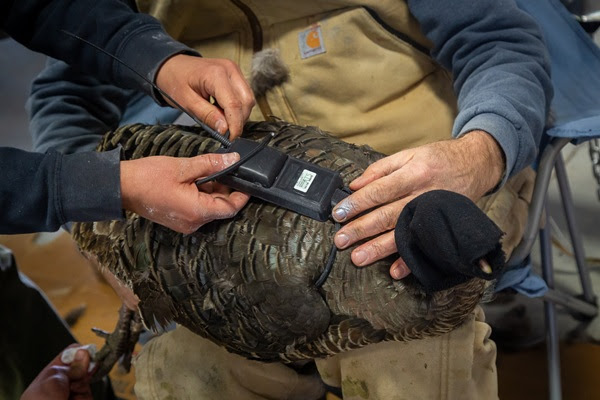EDGEFIELD, S.C. — The NWTF is helping fund numerous research projects led by Kansas State University; the Kansas Department of Wildlife and Parks; and the U.S. Geological Survey, Kansas Cooperative Fish and Wildlife Research Unit.
A catalyst for these projects was the stark figure that wild turkey populations have declined in Kansas by more than 40% since 2008. Suggested causes for the decline include loss of nesting and poult-rearing habitat, loss of habitat or required features of habitat (like foraging and roost sites), reduction in landscape carrying capacity, declining poult survival, changes in predator communities and more. However, many reasons are anecdotal and not grounded in peer-reviewed research — until now.
The Kansas Department of Parks and Wildlife and partners have initiated the largest-ever wild turkey study across Kansas that seeks to update critical wild turkey data, including survival, nest success, hunter influence and more, allowing wildlife managers to make decisions grounded in science and ultimately guiding the wild turkey’s sustainability into the future.
“The project as a whole is very large, so I think we can answer a tremendous number of questions about wild turkeys in Kansas just by this sheer scale and the tremendous number of birds and the sites across the state of Kansas that we are monitoring,” said David Haukos, Ph.D, KSU associate professor and unit leader at the Kansas Cooperative Fish and Wildlife Research Unit.
In addition to a poult and hen nutrition study, another aspect of the larger project is seeking to better understand predators on the landscape based on habitat types and the subsequent predation risk to wild turkeys.
The predation-habitat component of the research project is using trail cameras and occupancy modeling to better understand predator communities associated with wild turkey populations across different habitats in Kansas. Wildlife occupancy modeling is a statistical approach used to estimate the probability of a species being present at a specific location or area.
In a nutshell, this research seeks to collect data on how predators assemble in response to habitat use and movements by wild turkeys.
One of Haukos and his team’s primary goals is to understand the risk of wild turkey predation based on the habitat usage of each bird.
The primary predators of interest are coyote, bobcat, gray fox, red fox and northern raccoon. Additional potential predators of interest include the American badger, Virginia opossum, striped skunk and nine-banded armadillo.
Some of the key questions the researchers hope to answer are:
- How does the cover type or habitat affect what mammalian predators eat wild turkeys?
- How do predators vary across wild turkey populations in Kansas in regard to varying forest and vegetation densities?
- What are the estimated occupancy rates of predator species among study sites and cover types in Kansas?
- Are there relationships among estimated predator occupancy, land cover-patch type and other landscape features?
- Do predator occupancy rates influence habitat use by turkeys?
- Do predator occupancy rates change in relation to the ecological state of turkeys?
- What is the relative predation risk among cover types for turkeys, based on space use of monitored turkeys?
In 2024, Haukos and the research team captured 383 wild turkeys — 325 females, 58 males — at 13 sites across Kansas. These sites represent various habitat types. In 2025 the team captured 155 wild turkeys – 135 females and 20 males – at seven sites, including five new sites. The team has been monitoring the birds to determine if they were subjected to predation and will create a model of predation risk based on the type of habitat the wild turkeys and potential predators were using.
In addition, Haukos and the team established about 480 camera trap locations within each of the 13 sites in 2024 and will deploy cameras in an additional 300 locations in 2025 to capture potential predators of wild turkeys among various habitats.
“What I would like to do when we finish this project, and when we get an idea where these predators are relative to cover types, is to determine whether or not there are things that we can do on a large enough scale to manage habitat to provide alternative prey sources for predators or alternative locations or habitats for these predators to use that doesn’t correspond with high use by nesting and brooding hens,” Haukos said.
Haukos and team are currently in the project’s data collection phase, trapping and marking wild turkeys, examining habitat use, amassing trail camera photos of predators and preliminarily modeling the data. Field work and analyses will continue through the end of 2026.
In addition to funding through the NWTF’s national Science and Planning team, which is helping fund the project for its three-year duration, the Kansas NWTF State Chapter has also provided significant funding to the umbrella research project in Kansas.
“The NWTF is filling in some very important aspects of our project that the state is not able to fund at this time,” Haukos said.
The NWTF invested $655,447 into the above project along with eight other wild turkey research projects for the organization’s 2024 allocation.
Since 2022, with partner funds leveraged at more than a 10-to-1 ratio, the NWTF, its chapters, members and partners have combined to put more than $18 million toward wild turkey research. This number will increase as the NWTF’s national Science and Planning team is slated to fund more wild turkey research projects this year.
About the National Wild Turkey Federation
Since 1973, the National Wild Turkey Federation has invested over half a billion dollars into wildlife conservation and has positively impacted over 24 million acres of critical wildlife habitat. The NWTF has also invested over $10 million into wild turkey research to guide the management of the wild turkey population and to ensure sustainable populations into perpetuity. The organization continues to deliver its mission by working across boundaries on a landscape scale through its Four Shared Values: clean and abundant water, healthy forests and wildlife habitat, resilient communities, and robust recreational opportunities. With the help of its dedicated members, partners and staff, the NWTF continues its work to provide Healthy Habitats. and Healthy Harvests. for future generations.
Read the full article here




